| Danica (Danica) The perfect ball from a young age, grows no more than 60 cm. It grows slowly, at 20 years old height is about 50 cm. The needles are thick, soft, shiny, light green, in winter slightly bronze. It prefers the sun and partial shade, it is undemanding to the soil, tolerates dryness and excessive moisture. Wintering under the snow, practically does not suffer from spring burns. |
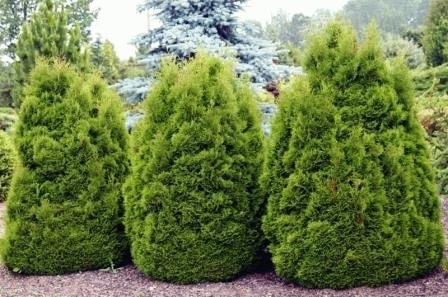 Dumosa (Dumosa) Dumosa (Dumosa) The crown is flattened or slightly rounded, the height and diameter are 1 m. At the top there are many vertical thin shoots 10-15 cm long. The needles are green all year. |
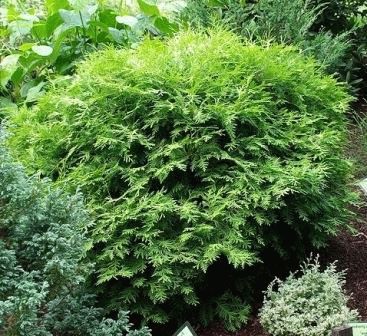 Globosa (Globoza) Globosa (Globoza) Shrub is spherical in shape, diameter and height not exceeding 2 m. The crown is dense and grows evenly in all directions. The needles are green in summer, brownish or grayish in winter. It grows slowly. More than other thuy needs frequent watering, rejuvenating pruning is recommended every 2 years. Its form is rounded at first, later conical, it can reach 2 m in height. Needles dull green, brownish in winter. |
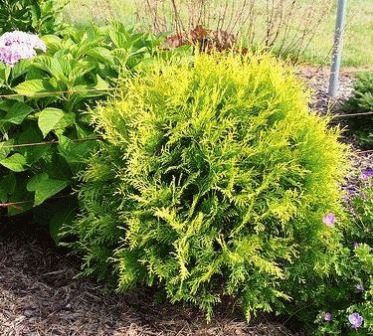 Golden globe (Golden Globe) Golden globe (Golden Globe) Shrub rounded shape, height and diameter of 1 m. It grows slowly, 8-10 cm per year. The needles are golden-yellow, in the autumn gets a copper shade. Prefers sun or partial shade. Haircut increases the density of the crown. |
 Little champion (Little Champion) Little champion (Little Champion) Dwarf thuja round shape. The ends of the branches hang slightly. At first it grows quickly, on reaching 50 cm the growth slows down. The needles are bright green, slightly turning brown in winter. |
 Recurva nana (Rekurva Nana) Recurva nana (Rekurva Nana) The name translates as "curved low." The branches are curved, the ends of young shoots are twisted. The krone is dense, terry, reminding a moss. |
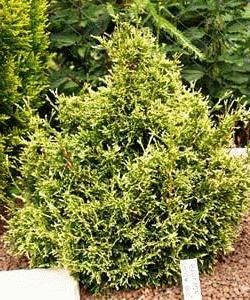 Stolwijk (Stolvik) Stolwijk (Stolvik) Shrub up to 1.5 m with a hemispherical crown. The lower part is thick, sparse upper, consists of several trunks. The needles are green, young growth is yellow-white. He loves the sun and fertile moist soil, does not tolerate dry air. |
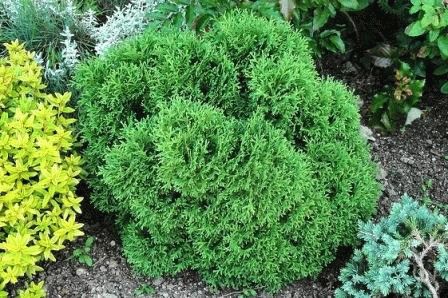 Tiny tim (Tini Tim) Tiny tim (Tini Tim) Very beautiful dwarf form with a rounded crown. It grows slowly, more than 1 m rarely grows. Twigs are short, form a lace spiral. The needles are dark green in winter turns brown. Light-requiring |
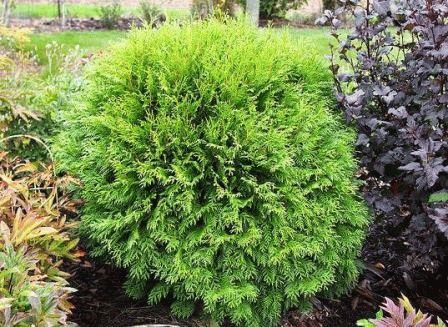 Woodwardii (Woodwary) Woodwardii (Woodwary) It is a dense ball, its height and diameter of 1.5 m. The needles are dark green, does not change color in winter. It grows slowly. In very harsh winters, it can freeze the ends of annual shoots. |
Thuya varieties of western original form
Today, thujas with an original form of shoots are highly valued, for example, Cristata (Kristat), which means "comb". This is a beautiful slender tree about 3 m high with a narrow, uneven crown, the branches are curved and directed upwards, the needles are greyish-green.
No less interesting Spiralis (Spiral), graceful, with a narrowly conic or columnar crown and a long sharp top, grows up to 5 m. The crown surface is highly wavy, because the lateral branches are spiral-twisted, the needles are bluish-green. In terms of growth rate, it is ahead of all garden forms.
Thuja cascade looks unusual Filiformis (Filiformis, "threadlike"). It has a thick, rounded crown and long hanging shoots. ![]()
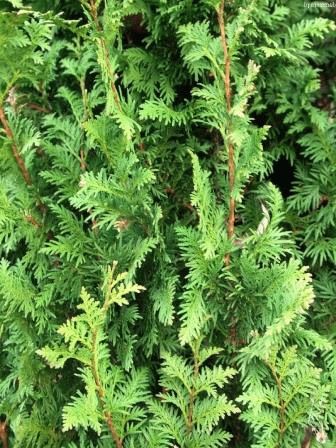
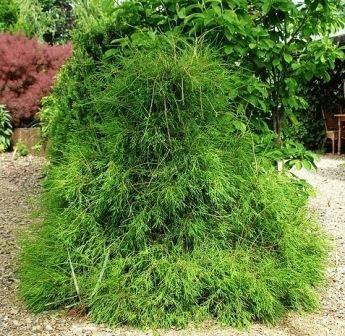
In "Modern Decorative Nursery » 15 varieties of western thuja are grown. Among the many ornamental varieties of Tui, we chose for breeding long-tried, widespread and winter-hardy in conditions of central Russia. From a wide variety of garden forms (there are already more than 120 of them), for the assortment, we selected varieties differing in the color of needles, sizes in adult condition and crown character. This approach allows us to meet the needs of customers when choosing varieties for various purposes of gardening, which can be divided into three areas:
1 – the use of tall thujas with the correct geometric shape of the crown as hedges;
2 – the use of varieties of thuas with different forms of crown and with contrasting colors of needles in soliternyh plantings and landscape compositions;
3 – the use of dwarf varieties of western thuja in the design of rockeries and rock gardens.
To create hedges from our range we can offer the following varieties:
(Thuja occidentalis "Brabant") - perhaps the most sought-after tree for this purpose is 4-5 meters high and its crown diameter is up to 1.5 meters. The crown is columnar, the needles are green, slightly turning brown in the winter months. Growing variety with an annual growth of 30-35 cm in height and 15 centimeters in width. Very cold. Perfectly tolerates a haircut, undemanding to the conditions of growth. It is widely used to create a hedge, creates the effect of "solid green wall." Buy thuy Brabant in the nursery can be of various sizes and at almost any time of the year.
(Thuja occidentalis "Columna") - a tree with a narrow columnar crown up to 6-7 meters high and up to 1.3 meters in diameter. The crown structure is dense, compact. The color of the needles is dark green, almost not changing color in winter. grows fast enough to 20 cm per year. To soils it is undemanding. Winter hardiness is high. It is interesting when creating hedges in the style of "Mediterranean", and is also used as a solo solo plant, reminiscent of the silhouette of the Crimean cypress trees.
(Thuja occidentalis "Smaragd") - tree up to 4-4.5 meters, having a pronounced conical shape, very dense structure. The needles are dark green, very saturated color. In winter, almost no fade. The growth rate is low. Demanding on growing conditions. Sotr prefers a highly fertile soil and regular watering. In the "hedge" in the upper part does not close, therefore it is used for the conditional delimitation of the garden space. Gorgeous as a solitaire in a single landing. The most presentable and best grade conical thuja. Widely represented in the nursery. It is possible to buy thuja Smaragd from a small size in a 2-liter container to a large tree with a clod of earth.
Thuja western Kholmstrup ( Thuja occidentalis "Holmstrup") - a tree up to 3-3.5 meters in diameter with a crown diameter up to 1 meter, with a column-like crown. The structure of the needles is very dense, you can say "curly." Unusually beautiful and does not change the color in winter. soil tolerant, hardy, tolerates shearing. This grade of a thuja is recommended to "lazy gardeners". Growth rates are very low. In a hedge it is possible to make cutting once in two years. Can be used for single landings and rokkariyev. The nursery of plants offers thuja western holmstrup also in the formed version in the form of various geometric shapes.
(Thuja occidentalis "Fastigiata") - very variable variety with a columnar crown, with shoots tightly pressed to the trunk. Needles from light green to dark green. Reaches in height in the conditions of an average strip of Russia to 6 meters. Undemanding to soil fertility and growth conditions. Very hardy. It is a great idea to buy thawed western Fasghiata and make a high living creature, closing an unsightly industrial landscape or an awkward building on a nearby site. And this variety of thuya is well suited for this.
For soliterny and group landings In addition to the varieties listed above, the following varieties grown in our nursery can be used:
(Thuja occidentalis "Sunkist") - large, dense shrub. The height is 3-5 m, the diameter of the crown is 1-2 m. The crown is conical. The needles of young plants are bright golden-yellow, changing with age to lemon yellow with age, in winter - bronze. It grows rather slowly. To soil conditions undemanding, light-requiring, tolerates a haircut. Hardy. Recommended for colorful mixed compositions and single landings.
(Thuja occidentalis "Cloth of Gold") - low shrub up to 2 meters. The crown is oblong-ovate or conical dense. The needles are very beautiful tender, yellow-orange hue, in winter it is coppery yellow. It grows slowly. Requires fertile well-aerated soils, with an alkaline reaction. Shade-tolerant Recommended for color compositions.
(Thuja occidentalis "Wagneri") – tree up to 3.5 m high. The crown is dense, ovate or conical-ovate. Shoots thin, ascending. The needles are dark green with a gray bloom, reddish in winter. Hardy, but may suffer from snowfall. Demanding on soil fertility and moisture. It grows better in open places. Recommended for single and group plantings.
(Thuja occidentalis "Globosa") - spherical shrub with a height and diameter of 2 m. Shoots are flat, densely located, overlapping, evenly expanding to the sides. Green needles shiny, in winter gray-green or brownish. Hardy Needs fertile wet soils. Recommended for single and group plantings.
Plant nursery grows also dwarf varieties of thuja to create compositions and planting plants in rokkarii. From this group we can offer 5 most popular varieties:
(Thuja occidentalis "Danica") - low shrub up to 60 cm and up to 1 m in diameter. The crown is spherical. Shoots are short, tightly spaced. The needles are thick, soft, light green, shiny, slightly bronze in winter. It grows slowly. From a young age, it retains an almost perfect spherical shape. To soil conditions undemanding, shade-tolerant, hardy. It is used in compositions, rock gardens, to create borders, ideal for planting small areas.
(Thuja occidentalis "Golden Globe") - shrub rounded shape up to 1 m in height and up to 1 m in diameter. The color of the needles is golden yellow. It grows slowly. Needs fertile and moist soils. It is winter-hardy. Recommended for rock gardens and color compositions in small gardens.
(Thuja occidentalis "Woodwardii") - dwarf variety with a height of 1.5 - 2.0 m, width - up to 2 m. The shape of the crown is spherical, wide-round towards old age. Shoots are straight, flat. The needles in the summer and in the winter dark green, do not change coloring. Demanding on soil fertility and moisture. Winter-hardy, but in the harsh winters freeze over the ends of annual shoots. Suitable for stony garden and planting on the lawn.
(Thuja occidentalis "Hoseri") - undersized variety with spherical crown with a diameter of up to 0.6 m. The needles are dark green. The variety is demanding of soil fertility and moisture, it is winter-hardy. Recommended for rock gardens, good for creating low curbs.
(Thuja occidentalis "Stolwijk") – shrub up to 1.5 m. The shape of the crown is hemispherical, the lower part is dense, the upper sparse with several trunks. The needles are green, young growths are yellow-white. Needs fertile and moist soils. Recommended for rock gardens, Japanese gardens, compositions.
Widespread now acquires gardening of balconies, terraces, offices and other premises with trees in containers. For these purposes, the following varieties can be used: "Danica", "Hoseri", "Golden Globe", "Smaragd", "Globosa" .
In our nursery you can purchase all the listed varieties of western thuja of various ages and sizes. All plants are sold well rooted either with a closed root system, or with an earthy clod, which allows us to guarantee their survival.
Tui of all varieties are in the nursery the entire growing cycle from cutting to adult plants. We sell our own planting material grown in our nursery! We are waiting for your visit!
How not cool, but most of all interesting and beautiful varieties in the western thuja. We suggest you familiarize yourself with some varieties that may later appear on your sites.
In total, about 150 varieties of western thuja are registered. Among them are found both tall and dwarf trees. Also derived several creeping forms. If you already know what kind you want and want to buy thuja, then you can purchase it from our partners KENNEL-TUY.RF. Below you can find descriptions of varieties of western thuja.
Thuja western ‘Albospicata’ (‘Alba’) (1875, Switzerland). A small, slow-growing tree, up to a maximum of 5 m tall, with a wide-conical, loose crown. The branches are open, the twigs are horizontal, flat. The tips of the young shoots are white, especially noticeable from mid-summer to autumn. A more beautiful variety with a wide columnar crown and a more generous white colouration - ‘Columbia’ (1887, USA).
Thuja western ‘Amber Glow’ (England). Mutation of the variety ica Danica ’. Dwarf variety of round shape, reaching 80-90 cm in diameter. Twigs are wide, flat, located in different planes, often folded in parallel rows. The needles are yellow, almost orange in autumn.
Thuja western ‘Aureospicata’ (until 1891, the origin is unknown). A small powerful tree with a conical sparse crown, at the age of 10 years, growth is 2-3 m. Potentially grows to 10 m. The branches are rough, tough, raised and sticking out. Young shoots are thick, with light yellow ends.
Thuja western ‘Aurescens’ (‘Polish Gold’) (1932, Poland). The crown is narrowly colonized, dense and even, at 10 years of growth - 2.5 m. Young shoots are golden yellow, flat, arranged chaotically.
Thuja ‘Bowling Ball’ (Mr. Bowling Ball ’,‘ Bobozam ’,‘ Linesville ’) (2003, USA). Dwarf shrub with a round dense and even crown, the maximum size of 60-70 cm in diameter. The branches are thin, often branching, arranged randomly. The needles are bright green, juvenile and scaly, often with protruding tops. Was found as a witch's broom around 1985.
Thuja western ‘Barabits Gold’ (Hungary). The crown is dense, pyramidal, rather flat, with a rounded tip. The maximum height is 10 m with a width of 2 m. The twigs are flat, thick, oriented mainly in the vertical plane. Young shoots are yellow, especially bright at the ends.
Tuya ‘Bodmeri’ (1891, Sweden). Bush tree potentially up to 2.5 m tall. The crown is loose, broadly conical, with a rounded tip. The branches are thick, rough, sticking up at a sharp angle. The branches are flat, at the base of the branches are large, drooping, at the tops - small, ugly, sticking out and crowded. On old plants in the mass dead. Young shoots can be flat and tetrahedral due to keeled needles. The needles are blue-green, dark.
Sort thuja ‘Brobecks Tower’ (Sweden). Ея Spiralis ’seedling. The crown is narrow pyramidal, with a wavy surface. The specified height is up to 2.5 m. The branches are short and wide, fan-shaped, with numerous dense and short young shoots (comb-like), curved, located mainly horizontally. The needles are bright green.
Thuja western ‘Cloth of Gold’ (1831, United States). We have under this name for sale shrub with a dense, even crown, initially round, then wide - pyramidal. The indicated age is 10 years: 1.5 m height, 1 m width. The branches are arranged chaotically. Young shoots are thin. Juvenile leaves, light green in the center of the crown, yellowing to the ends of the shoots, orange-yellow at the ends, especially bright to fall. Those. this is very similar to the ‘Rheingold’ variety, especially since with age these young shoots appear with scaly leaves. According to Krussman’s description, true ‘Cloth of Gold’ is a loose, slow-growing shrub that has scaly, light yellow needles. Such plants offers, for example, Holland (Esveld).
Thuja western ‘Cristata’ (1867). Straight tree up to 3 m tall with a narrow, uneven crown. Skeletal branches are curved and directed upwards. The twigs, especially on the tips of the shoots, are short, comb-shaped (arranged in two rows and twisted), variously directed. The needles are greyish-green. At an early age, it resembles the related varieties of “Degroot’s Spire’ or ‘Brobecks Tower’.
Tuya ‘Degroot’s Spire’ (‘DeGroots Spire’). (1985, Canada). The narrow columnar form up to 3 (5) m tall, very uneven at an early age. Sprigs fan-shaped, comb and twisted, laid in dense layers on each other, which creates a characteristic spiral and wavy pattern on the surface of the crown. The needles are pure green. Ея Spiralis ’seedling.
Tui variety ‘Danica’ (1948, Denmark). Dwarf shrub with a dense rounded crown. At the age of 20 years to 50 cm tall. The needles are bright green in summer and brownish in winter. The branches are fan-shaped, mainly located in a vertical plane in parallel rows. Very popular.
Thuja "Dumosa’ (‘Nana’, ‘Wareana Globosa’). Dwarf variety with a rounded, somewhat flattened crown about 1 m in diameter. Shoots are uneven, partly curved, mostly tetrahedral, but there are quite flat. At the top there are a lot of vertical shoots 1015 cm long with the usual cover. Often confused with other varieties, in particular ‘Recurva Nana’. By contrast, the needles remain green all year.
Thuja western ‘Douglasii Pyramidalis’ (1891, United States). The crown is narrowly colonized, up to 10 (15) m tall, dense, with a wavy surface. The needles are dark green. Sprigs are short, vertically arranged, twisted.
Thuja western ‘Elegantissima’ (until 1930, the origin is unknown). In some kennels it is considered a synonym for ‘Aureospicata’. Reference books also interpret this variety ambiguously (according to Krussman, this is a broad-pyramidal form, in which the ends of the shoots are yellow in summer and brown in winter.
Thuja western ‘Ellwangeriana’ (1869, United States). The tree, often multi-peaked, is up to 2.5 m tall. The crown is wide-conical, loose, openwork. Skeletal branches raised, highly branched. Young shoots are thin. The needles are partly juvenile and scaly.
Tui variety ‘Ellwangeriana Aurea’ (1895, Germany). Yellow mutation ‘Ellwa- ngiana’. The lower and slow growing form than the green one hardly reaches 1 m in height. Similar to her crown shape and branching. Young plants are egg-shaped. Juvenile and scaly needles, green inside the crown, dark yellow at the ends of the shoots, bronze after frosts.
Thuja western ‘Europa Gold’ (1974, Holland). A small, slowly growing tree with a narrow, dense and even pyramidal crown. At 13 years old 1.8 m tall (St. Petersburg). Golden yellow needles, acquires an orange tint in winter.
Tuya ‘Fastigiata’ (‘Pyramidalis’, ‘Stricta’) (1865 or 1904, Germany). Multiple tree up to 15 m tall. The crown is wide, columnar, dense. Skeletal branches are short, directed upwards. Twigs are flat, small, thick, horizontally arranged, twisted at the ends. Reproduced by seed, so that the form can vary.
Tui variety ‘Filiformis’ (1901, United States). Shrub up to 2 m tall, with a dense, conical crown, which with age becomes rounded and wide. Young shoots are long, rounded, hanging, weakly branchy. Split needles, partly long pointed. After frosts it gets a bronze tint.
Thuy variety ‘Frieslandia’. Broad pyramidal shape up to 5 m tall with a pointed tip. The crown surface is quite loose, uneven. The branches are large, horizontally located, with drooping ends. The needles are dark green.
Tui variety ‘Hetz Wintergreen’ (‘Wintergreen’) (1950, USA). Narrow pyramidal or columnar shape up to 7-9 m in height at 2.5 m width with a pointed tip. Growing fast. The surface of the crown is loose, fairly flat. The branches are large, arranged randomly. The needles are dark green all year.
Tui variety ‘Holmstrup’ (1951, Denmark). It grows slowly. Approximate height of 2 m and more. The crown is narrowly conical, compact and dense, with a smooth surface. The tip is loose, with long, weakly-branched shoots. The curved fans of the branches are oriented mainly vertically. Green needles throughout the year. The material sold under this name is quite heterogeneous.
Thuy‘Hoseri ’variety (1958, Poland). Dwarf variety, with a round, smooth crown, at the age of 10 years, 0.4 m in diameter. Annual growth of up to 4 cm. The twigs are small, arranged chaotically, with young shoots protruding, the surface of the crown looks fluffy. Emerald green needles, bright.
Tuya ‘Hoveyi’ (1868). Dwarf multi-stemmed shrub egg-shaped or oval, reaching 1.5 (2) m in height. The krone is dense, with a smooth surface. The branches are thin, fan-shaped, flat, arranged in vertical rows. The needles are light green, in winter brownish.
Thuja western ‘Little Champion’ (‘McConnel’s Globe’) (1956, Canada). Dwarf round shape with a smooth surface. Up to a height of 50 cm, it grows quickly, then growth slows down. The twigs are small, flat and slightly arched, thick, arranged horizontally and evenly, the ends of which hang slightly. The needles are bright green, slightly turning brown in winter.
Thuja western ‘Little Gem’ (1891, Germany). Dwarf pillow shrub up to 1 m tall, 2 m wide. The branches are thin, prostrate horizontally, densely branched. The branches are small, curved, located in different planes, so that the surface of the crown is as if covered with small swirling waves. Young shoots curly, completely flat, up to 3 mm wide. The needles are dark.
Tui variety ‘Little Giant’ (Canada). Dwarf variety with ovate-oval dense crown with a rounded tip. Height up to 2 m. The surface of the crown is flat. The branches are very small, arranged evenly and neatly, mainly in the horizontal plane.
Tui variety ‘Lutea’ (until 1873, Switzerland). Up to 10 m tall. Crohn slender pyramid, pointed, dense, with a wavy-lumpy surface. The branches are large, flat, oriented in different planes. As can be seen in the photo, the western ‘Lutea’ thuja needles are golden-yellow from above and greenish-yellow from below, generally turning green when shaded.
Thuy variety ‘Malonyana’ (1913, Slovakia). Tree 10-15 m tall with a narrow and sharp columnar crown with a slightly wavy surface. The branches are thick, short. Sprigs fan-shaped, curved, oriented in different planes, but mostly vertically, form wavy winding patterns on the surface of the crown. The needles are brilliant, pure green.
Thuy variety ‘Malonyana Holub’ (Czech). Dwarf shrub of an ugly form. Skeletal branches are vertical and ascending, few, weakly branchy. They are covered with moss like small green and crowded branches with short straight shoots. Emerald green needles.
Tui variety ‘Miky’. Dwarf, with an oval and pointed shape of a very dense crown. In 10 years, the growth of 0.6 m. The surface is lumpy-wavy, tender, needle-like. The branches are small, with short young shoots, narrow-fan-shaped, curved, located in different planes. The needles are bright green in summer, after frosts - reddish-brown. Sport varieties ‘Smaragd’, according to some sources, according to others - ‘Holmstrup’.
Tuya ‘Ohlendorffii’ (Until 1887, Germany). Dwarf bushy form up to 1 m tall with a vertical growth pattern. Crohn loose, irregular. Sprigs with short and long, slightly branched, cord-shaped young shoots. Young shoots are tetrahedral, only flattened at the ends. The needles are mostly juvenile, only cord-shaped shoots are covered with scaly needles.
Thuy variety ‘Pumila’. Dwarf. The crown is rounded ovoid, reaching 2 m in height with age. Sprigs are fan-shaped, slightly curved, spread out in a horizontal plane, not in contact. Young shoots are flat, thin, up to 2 mm wide, dark green above, lighter below. Sometimes identified with ‘Little Gem’.
Tui variety ‘Pyramidalis Compacta’(1904). Narrow pyramidal, grows slowly, up to 10 m or more in height, with a pointed tip. The surface of the crown is quite flat. Skeletal branches raised. The branches are fan-shaped, horizontally prostrate. Young shoots straight, close, short. The needles are light green, duller, larger and sharper than those of the similar variety ‘Columna’.
Thuja variety ‘Recurva Nana’ (1867). Dwarf. At a young age, the crown is rounded, later - conical, up to 2 m tall. Branches raised or prostrate, with curved ends. Twigs flat and narrow, also curved. The ends of the young shoots are twisted and twisted, so that the surface of the crown resembles moss. The needles are often located randomly, dull green, brownish in winter.
Thuja western ‘Recurvata’ (1891). Conical dense form about 1.5 m in height. Skeletal branches are thick, partly diversely curved. Twigs are narrow, small, with young shoots spread out. The ends of the young shoots ugly and curved. Abundantly fruiting.
Thuy variety ‘Rheingold’ (1904, Germany). Cultivar. It is practically a vegetatively propagated juvenile shoots of the variety ‘Ellwangeriana Aurea’. Coloring pine needles from golden yellow to orange yellow. With age, young shoots appear with scaly needles and plants take on the characteristic appearance of the parent variety. In nurseries practiced plucking "adult" shoots.
Tui variety ‘Riversii’ (until 1891, England). The shape of the average height, indicated up to 5 m. The crown is pyramidal, flat. Sprigs are flat, with drooping ends, oriented chaotically. The needles in summer are yellow, in winter they are yellowish-green.
Tuya ‘Rosenthalii’ (1884). Dwarf columnar shape with a smooth surface, in 50 years, height 2-3 m. The branches are short, tough, very thick. The twigs are mostly horizontal, very tight. The needles are brilliant, dark green.
Variety ‘Salaspils’ (1928-32, Latvia). Dwarf bushy form with a dense rounded crown. At the age of 30, height is 55 cm. The branches are tightly, chaotically. The needles are bright green throughout the year. Mutation с Globosa ’.
Thuy variety ‘Sémreraraea’ (‘Aureospicata’) (1893). Pyramidal shape up to 5 (10) m tall. The branch is thick. The needles are brilliant green, golden-yellow at the ends of young shoots, darkening in winter. Perhaps a hybrid of thuja western and folded.
Tui variety ‘Spiralis’ (‘Filicoides’, ‘Lycopodioi- des’) (1920). Fast growing graceful form with a narrow pyramidal or columnar crown with a long sharp top. It reaches a height of 10-15 m. At 10 years old, the height is 3 m. The crown surface is uneven, loose, strongly wavy. Skeletal branches are short, ascending, lateral twisted spirals. The twigs are narrow, crowded with densely sitting and overlapping short young shoots, resemble a leaf of a fern. Are located chaotically. The needles are dark green.
Thuy variety ‘Starstruck’. The crown shape and branching is similar to the variety ‘Smaragd’. The indicated height at 10 years is about 2 m. The needles are mostly bright green, in some sections of the twigs - yellow. A similar variety is ‘Spotty Smaragd’.
Thuy variety ‘Stolwijk’ (1986, Holland). Dwarf, with a vertical character of growth. The krone is oval, dense, with a smooth surface and a rounded tip. The height by 10 years is about 1 m. The branches are flat, sticking out, oriented randomly, the young shoots are long, sparse, thick. The ends of the young shoots are creamy, by the autumn the coloring becomes brighter, whiter.
Thuy variety ‘Sunkist’ (until 1960, Holland). Pyramidal tree with a flat crown and a sharp top. By 10 years reaches 2 m in height, the maximum height is 5 m. The branches are prostrate. The branches are large, loose, located in different planes. The needles are light yellow, brighter at the ends of young shoots, turning green on their inner parts.
Tui variety ‘Teddy’ (‘Teddy Bear’) (until 1998, Germany). Cultivar. The catalogs provide the following description: “Dwarf densely branched variety with a smooth surface. At the age of 10 years, the diameter is 0.3 m. For an adult plant, the diameter is 0.6 m. The needles are juvenile, bright green. At the ends of young shoots yellowish or bronze. In winter it gets a gray color. ” However, we have such specimens at the age of 15 years have reached a height of 1.5 m and acquired a dense column-like form. Sprigs are fan-shaped, wavy, oriented horizontally. The needles became scale-like, juvenile disappeared, and in winter it acquires a bronze tint.
Hello, the topic of today's article "Tui species and varieties with photos." Thuja belongs to cypress plants, it is easy to shape, has many types and can be used to create living partitions and fences. In Russia, shrubs love because it is evergreen and does not require care in the winter.
Thuja species and varieties with photos
In the middle zone of the country and in the north, it is desirable to use winter-hardy varieties of thuja bushes. They do not require attention to themselves and survive well in winter. Consider what types of Tui and varieties exist, and of course we will apply for better visibility of the photo of trees.
The tree grows up to 5 meters high, the crown volume reaches 1.5 meters. The color of the needles is mostly green; if it is cold in winter, the color of the needles may become brown. This is not significant, because by spring the tree turns green again.
Every year the tree grows up to 35 centimeters in height and 50% of this height in width. The plant can be cut, it is well tolerated procedure. In winter, the tree does not freeze, you do not need to cover it.
The shrub is not demanding to the type of soil, it can do without additional dressings. Shrub grows normally, both in the sun and in light shade. It is advisable to plant the plants in places where there is no strong wind.
The tree may bloom, it happens in the spring. After flowering, you can find small cones of brown shade on it. Seeds ripen fully in autumn. For this type of Tui, sudden temperature drops and regions where there is a long thaw are not desirable.
The tree's life system takes a thaw for the onset of spring and the process of sap movement may begin, and as a result, the young shoots will freeze when frost comes.
If you want a tree to grow juicy and green, you should plant it in fertile soil and constantly maintain optimum humidity. Otherwise, a lot of fruits appear on the thuja, the shoots become rare and not as fluffy as they could be.
A suitable type of land for a tree: peat, sand and 2 parts of sod and leaf land. For an adult plant, 500 grams of nitroammofosca is added to each hole.
In regions where there is increased humidity of the earth and frequent rainfall before planting this species of thuja, it is better to do drainage. Usually it is 20 centimeters per hole.
If you buy a plant in pots, then water it well before planting in open ground so that the roots lag behind the earthen clod. The root neck when planting a plant must remain above the ground, otherwise there is a risk that the tree will die.
After planting a tree need to monitor its watering. Initially, it is watered only once a week, using a bucket of water for one tree. After a month has passed after rooting, the amount of water is increased by 2 times.
Periodically, the ground under the tree must be mulched or loosened. Take care not to damage the root system. Sometimes wood chips and peat are used for mulching, they are laid down 7 centimeters in depth, not more.
If there are dry shoots, it is desirable to remove them in the spring before the movement of the juice begins. Growing young trees involves shelter for the winter. This will help keep tender needles from the winter frost, and in the spring from sunburn in the sun. Typically, for this purpose is used lapnik.
The tree is actively used to create hedges. If you want to get a dense wall, then plant a thuja every 50 centimeters. Pruned shoots in March and autumn, this allows the crown to better form and become durable.
If you trim the treetops in a timely manner, they will grow evenly and stop moving upwards. Diligent care and timely circumcision will lead to the fact that you get a full live fence.
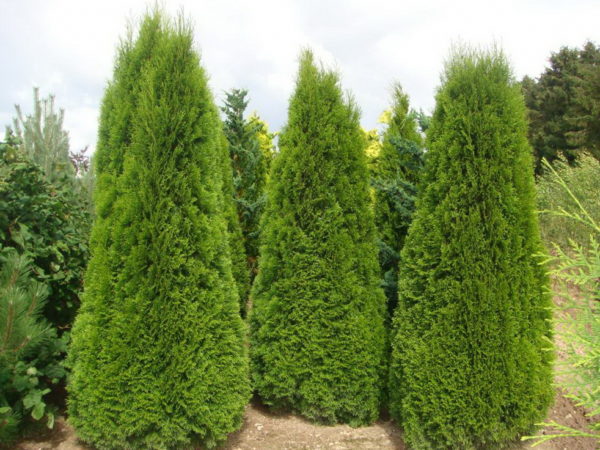
The tree can grow up to 7 meters in height, in winter the needles remain green. The plant is not afraid of the frost, it does not require special composition. Crohn grows dense, normal type. In a year a tree can add up to 20 centimeters in height.
Tuyu can be cut and thereby form the desired height of the tree. The tree of this type is used to create partitions and fences. If Columna grows alone on a plot, it will resemble a Crimean cypress. If you think about the idea of landscape design, the tree will perfectly fit into the plot.
The tree can grow in the ground of any type, does not require additional dressing. At the same time, thuja will develop better if it is grown in fertile soil conditions and maintains soil moisture.
The tree does not tolerate drought very well, so you need to carefully monitor the quality and quantity of watering. The tree will develop best of all if it is planted in a place where there is not too much sun. You can trim a tree by giving it the desired shape, the thuja quietly tolerates this fact and will grow in the direction you need.
If you plant young, then it should be covered for the winter. This is done in order to avoid burns and damage to young shoots cold. The tree can be used for growing in groups or single compositions.
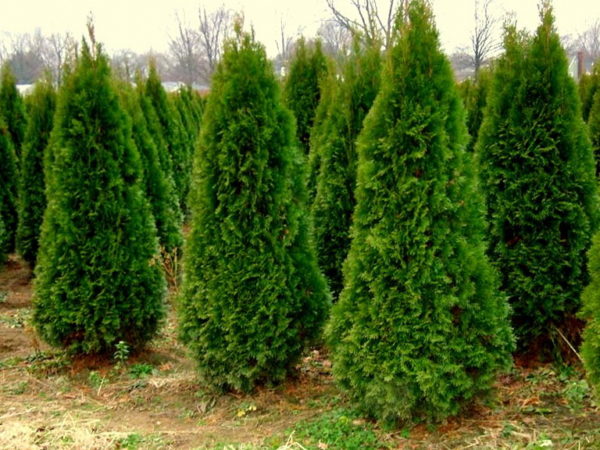
Thuja grows 5 meters high, it requires special attention. To grow this tree is only in the fertile land, it is good to follow the watering. Thuja of this variety grows weakly, a few centimeters per year.
In winter, the color of the needles does not change, which decorates the site quite well when all the plants are sleeping. A hedge of such trees is weak. During growth, the thuja does not close in with other treetops, which spoils the view of the hedge.
This plant can be used for growing in tubs or single compositions. A place for such a thuja is better to choose the sun, but the tree can calmly grow on the ground where there is a shadow.
Cold Smaragd transfers normally. Plant trees in areas where there is no wind, because frostbite can occur on particularly cold days. The young for the winter is covered with burlap or other material. If this is not done there is a chance that the young shoots will die under the rays of the spring sun or freeze in the winter.
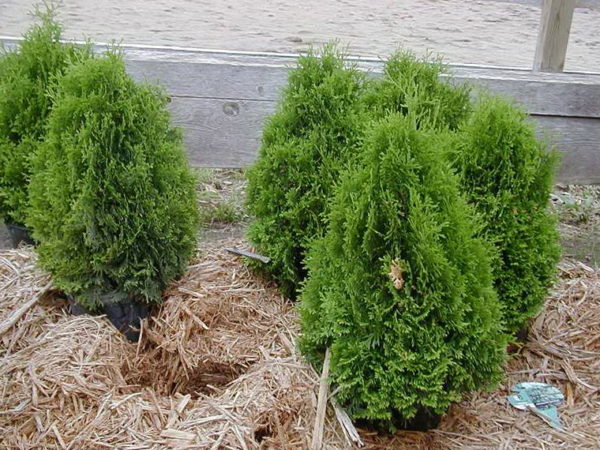
The tree grows up to 3.5 meters in height, in form resembles a column. The width of the branches in the region of one meter, shoots grow thickly, the crown turns out to be dense. The tree does not change color under temperature drops. In winter, thuja looks green and juicy, does not freeze during severe frosts. The plant can be shaped; it tolerates cutting of shoots normally.
Thuja does not require special attention and can grow on the ground of any type. It grows to its standard length in 20 years. On average, a tree adds 12 centimeters per year. If you create a hedge of trees of this type, then you need to prune shoots about once every 2 years.
Holstrup is well suited for those who create a garden for several generations, but do not want it to take a lot of time. The tree will grow well in loose soil with good fertility.
Watering is required moderate, thuja does not like drought. The first 3 years of life the plants are covered for the winter with insulating material, the ground at the roots should be covered with spruce leaves so that field mice do not climb. The plant is beautifully used for single compositions, rockeries or creating a hedge.
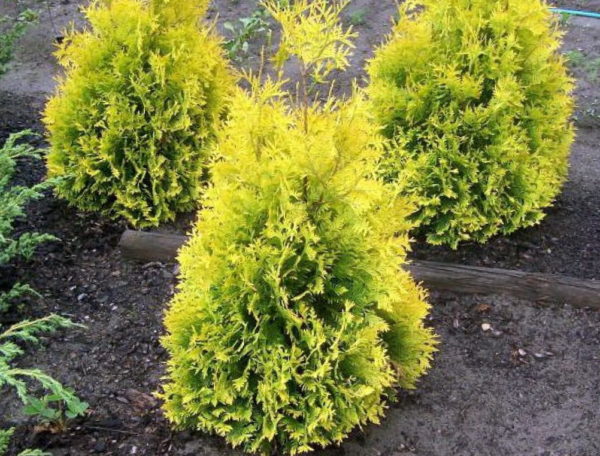
Thuja of this species can be of two types: a small tree or a shrub. It usually grows to a height of 3 meters. The needles have a light brown shade and grows in different directions. Juveniles have a golden hue, and with age the tree becomes almost bronze.
The variety has a very slow growth. For 10 years, the tree will reach only to a height of 2 meters. A tree should be planted where there is a lot of light. Land for planting can be any, but it is better to take the land with good fertility and monitor the mode of irrigation.
You can cut the thuja without fear that it will die, the tree adapts well to the haircut. Usually does not freeze in winter. If the irrigation system is disturbed for a long time, the thuja will be covered with numerous seeds and lose its decorative appearance.
If you plant a plant in the penumbra it will end up in that the natural color of the needles will disappear and it will turn green. For the landing of these plants, an enclosed place is chosen, where the wind does not blow much. To cut thuyu of this species is optional, as well as to form a crown.
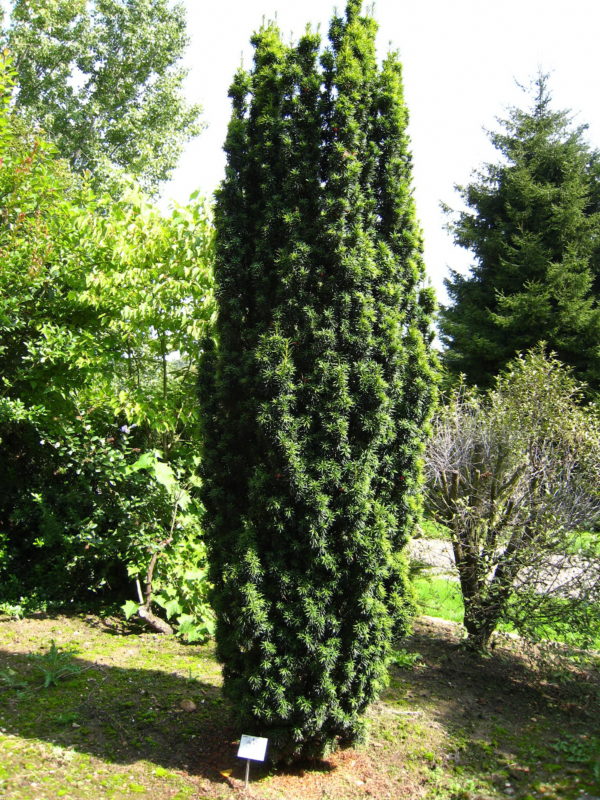
This tree in its form is similar to the Crimean cypress. In height it is pulled out up to 6 meters. Shoots are pulled out quite quickly, for a year can grow up to 30 centimeters of new volume.
The color of the needles is green, it has a characteristic aroma for thuja and is soft to the touch. The tree calmly carries the winter in the middle zone of the country. When seeds appear in the form of cones, they are practically not visible on the tree.
Tuyu is to cut and shape her crown. If you do not do this, it may end up in that the tree grows in different directions and turns into a huge and untidy shrub.
Thuja grows well in loamy fertile soil. It is also necessary to monitor the humidity regime. A lot of water will not benefit the plant. If you have frequent rainfall or high soil moisture in the region, you should take care of a good drainage system.
For the winter, the youngsters cover them with sacking from the cold and do not remove them until the temperature stabilizes. Periodically, mulching of the soil with dried grass should be done. This will help improve land quality and tree growth. Thuja of this species is used mainly to create a hedge. This fence looks beautiful, does not take up much space and fits into the landscape design.
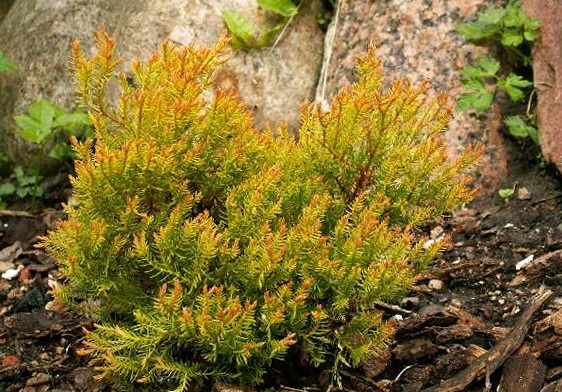
Tuyu of this species can hardly be called a tree, its size rarely reaches 2 meters. The thuja of this plant can be in the form of needles or scales. Under the influence of reduced temperature it becomes almost a copper shade.
In the year of thuya gives a small increase and requires attention. Well planted in fertile soil with good drainage. An important factor is the presence of alkali and optimum humidity. Thuja does not like excess water.
Plant the plant better in a bright place. If the tree grows in partial shade, then the color of the crown will soon deteriorate. The plant requires regular pruning, usually cut off the third part of the shoot.
An adult plant is not afraid of the cold, and the young in the first year of life should be sheltered for the winter. Thuja is used to create small compositions, decorative living fences and for a single landing.
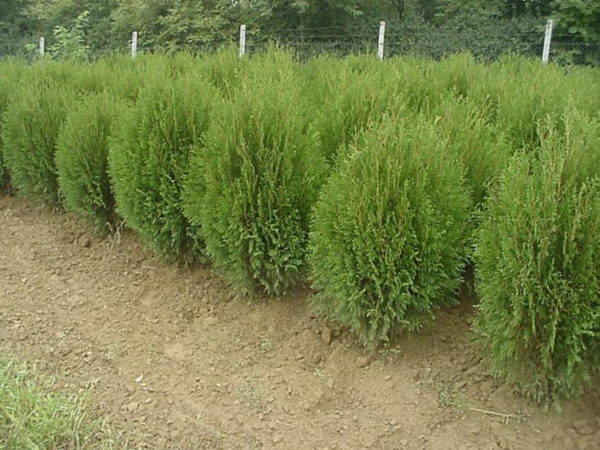
In good conditions, the bush can grow up to 3 meters or more. Initially, thuja needles are green, but by the winter they acquire a copper hue. A tree should be planted in an open place where there is a lot of sun. At the same time, avoid places where a strong wind blows.
Thuja will grow well in fertile soil with optimum moisture.
Pruning the plant is done only if necessary, thuja well maintains its shape. In winter, the crown may break under the snow cover.
In order for this not to happen, you need to tie the shoots together, but see that the rope is not tight. Otherwise, it is possible to damage the shoots. Thuja is not afraid of frosts, which are quite common in the middle zone of the country.
The plant can be grown in pots, used to form avenues or create separate landscape decorations.
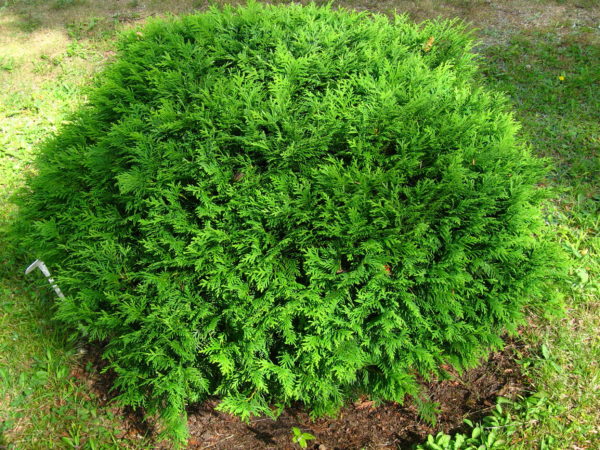
This variety of thuja is considered undersized. In form, the bush resembles a ball within a radius of 60 centimeters. In spring, the needles have a juicy green shade, and in winter they become copper-colored. The older the bush, the denser the needles.
The bush grows rather slowly, for a year it adds only a few centimeters in volume. It is better to plant the plants in fertile soil and observe the watering regime. It is desirable that the humidity was average.
Cold this kind of Tui is not afraid. Youngsters may well winter through the snow. In the summer heat should pay attention to watering plants. With a good level of humidity, the shrub will grow and become a juicy green shade.
In order for the plant to develop better use soil mulching. This is done by peat or mowed grass. In autumn, the ground around the shrub root system should be covered with spruce leaves so that the thuja is no longer attractive for mice.
The plant does not need to cut and give it shape. Thuja of this variety is used to divide the garden into functional areas, create flower beds. A shrub looks good in tubs and when planted in small groups.
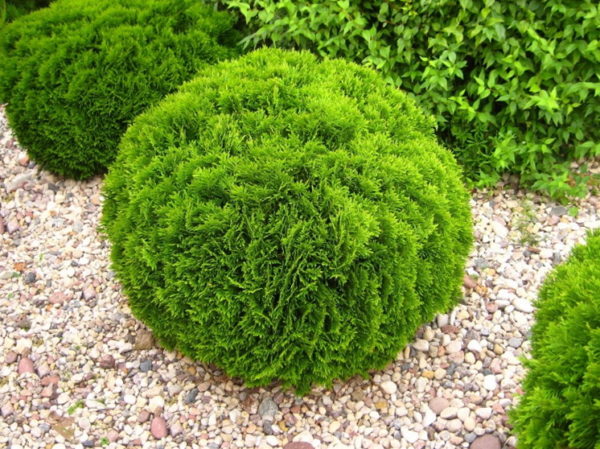
The shrub resembles a ball in diameter up to one meter. Thuja grows rather slowly, for a whole year, the crown growth is 5 centimeters. Cutting and shaping the crown for a bush is not necessary.
The young growth will become an adult full-fledged bush only after 15 years. Shrub reproduction occurs mainly by cutting, but you can buy ready-made plants grown in a nursery.
Grow thuya of this variety can be in the sun and in the shade. In winter, the plant does not react much to frost and does not freeze. Danica is actively used to create rock gardens, fencing for flower beds, hedges and zoning space.
Completely in the shade, the thuja will turn into a shaggy shrub that cannot be shaped. If you pay minimal attention to the plant, it will perfectly fit into the landscape design of your site.
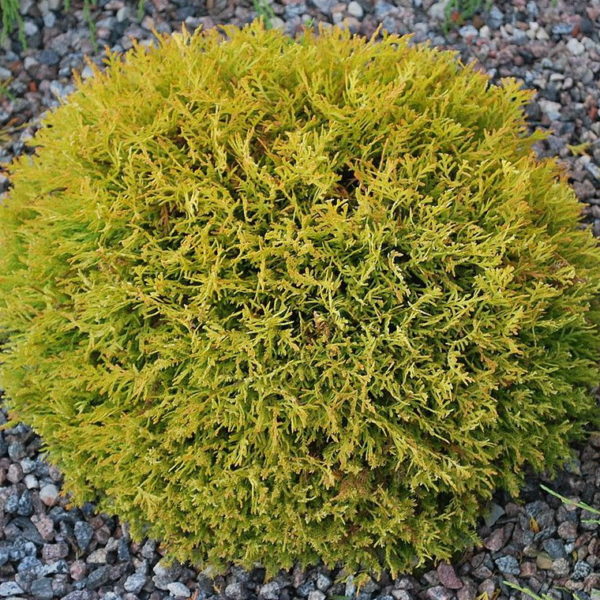
Another variety of undersized Tui, resembling a ball in appearance. The height and diameter of the plant is about the same and is 1 meter. The shrub grows beautifully, is not afraid of frost and can winter without shelter.
Needles have a greenish-yellow shade, which becomes more pronounced with the onset of winter. The increase in the volume of the thuja is rather slow; over the year it can grow to a maximum of 10 centimeters. In order for the plant to acquire a magnificent shape and a diameter of 2 meters must pass 20 years.
For the cultivation of this type of thuja need loamy soil. The plant needs regular watering and fertilizer mineral and organic substances. In addition, it is necessary to mulch the earth to enrich it with oxygen and improve the growth rate of the plant.
Mulching of the land is done by grass or peat; in autumn, the ground around the roots should be covered with spruce branches. The main pests of the thuja are field mice. They make nests near the root system and gnaw it. When the soil is covered with spruce branches, it is not so easy to harm the plant.
Thuja Golden Glob does not like dry hot air. In the summer heat it is necessary to water the bush more often and spray it with water from a garden hose. Watch the plant carefully throughout the year. If suddenly the thuja becomes faded, and the needles are spreading to the sides, then it's time to cut the plant.
After you cut off part of the shoots, the shrub will develop better, and the needles will acquire a rich color. You can use the plant in rock gardens, rockeries, to create a single planting with the use of pebbles and sand.
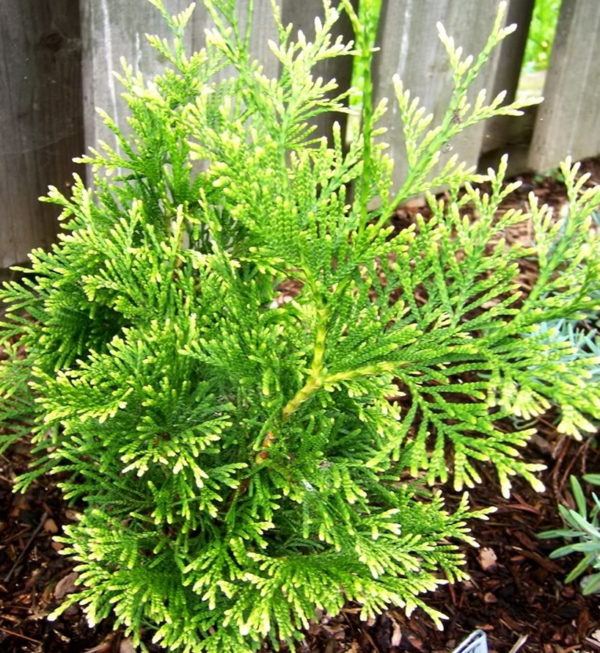
This type of thuja resembles shrubs and grows up to 1.5 meters. For the full development of the bush will take 10 years. The needles of the shrub have a green color. The plant tolerates frost normally and does not change color from the cold.
It is better to plant the plant on fertile land and follow the moisture regime. Reproduction occurs by cuttings or you can buy ready-made plants in tubs. Growing thuja from cuttings will take much longer than when you buy ready-made seedlings.
Tuyu of this variety is planted in a sunny area. In the shade the shrub becomes loose with needles of an incomprehensible shade. The plant does not tolerate overdried air, it must be regularly sprayed with water all summer.
For better plant growth, the soil should be mulched with peat or grass. In autumn, the soil at the root system is covered with spruce leaves to protect against small rodents. Young animals are not afraid of frost, so they do not need to be sheltered from the cold.
It is necessary to form a crown of thuja, if you want to give it some interesting shape. Clipped shoots grow back quickly. Shrubs of this type are used to create a living fence, zoning space and creating simple landscape decorations.
We hope you liked the article "Tui species and varieties with photos"!
Tui will decorate any house or city territory, at the same time performing other important functions - purification, ionization and aromatization of the surrounding air, protection from prying eyes and city noise. The name Thuja is derived from Greek incense, which is associated with a pleasant, specific aroma during the burning of wood.
Description
Thuja (lat. Thúja) belongs to the cypress family. This genus of conifers is represented by evergreen shrubs, trees, large tall specimens are rare. Have a dense crown formed by numerous shoots, branched in one plane. The leaves of young plants have a soft needle-like structure, adults are formed by flat scales, tightly overlapping each other. Crosswise opposite. The color of the foliage can be different - from all shades of green to red, and even multi-colored.
Plants monoecious, gymnosperms. The oval-shaped cones are oblong, covered with paired scales, the upper ones are sterile, the rest contain up to 3 ovules with flat, narrow-winged seeds. Seeds ripen in the first life cycle of the plant.
Types and varieties
In the natural conditions of our country, thuja does not occur, its various species are imported from the northern part of America, the eastern regions of Asia. In the natural conditions of these regions there are five types of thuja and their countless varieties. Currently, there are about 120 varieties of thuja on the basis of the main natural species, which differ in the shape of the crown, the color of the needles and other external signs.
T. Eastern (lat. T. orientalis) - comes from the Chinese expanses. Prefers the shadow of large trees. Differs fan-shaped branches, poor frost resistance, grown in the southern regions. It has valuable medicinal, health properties.
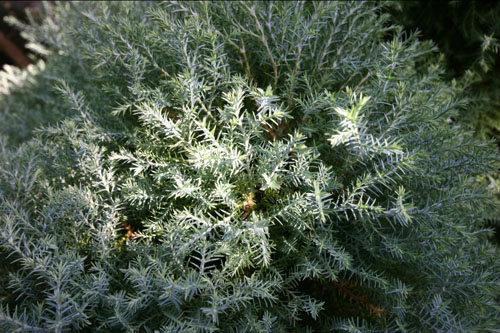
Thuja east, Juniperoïdes ’grade
T. Western (Latin T. occidentalis) - gained the greatest popularity among gardeners, caught on almost everywhere. She comes from North America, is distinguished by unpretentiousness to the ground, in natural conditions she prefers moist clay soils of mixed forests. It is characterized by: compact bright green crown, reddish wood of the trunk, small size of the cones, the ability to change the green color to brown in winter.
She light-requiring, but shade-tolerant. Lives up to one hundred years, depending on the variety, it looks like a shrub or tree, the height of which is insignificant and rarely reaches 2 m. The tree has light, resistant to rotting wood with a high content of essential oils, improves the surrounding air due to the release of volatile production. On the basis of this species, more than a hundred popular varieties were bred.
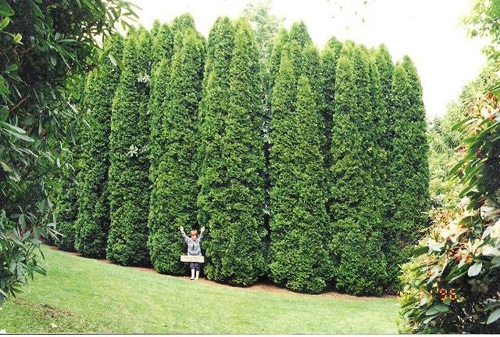
Thuja western, grade ‘Pyramidalis’
T. folded or gigantic (Latin T. plicata = T. gigantea, T. lobbii) - grows exclusively in southern places, distinguished by an increased sensitivity to cold. Frozen shoots in winter are able to recover. In nature, it is she who reaches 60-70 m in height, the diameter of the trunk is up to 2 m. New varieties are more compact. It has a pyramidal crown, a specific, strongly pronounced aroma.
T. Japanese or Standish (lat. T. jaro nisa = T. standishii) - in nature found in mixed forests of highland regions of the Japanese islands. It can reach a height of 18 m. It differs with beautiful soft needles with an original color: at the top - green, in the opposite part - white, with a strong smell of resin ate. Extremely hardy, taking root in the most northern areas, not intended for the city - too much likes clean air.
T. Korean (Latin T. koraiensis) - a spectacular shrub with spreading branches, a wide crown, soft needles with a non-uniform color - dark green in front, bright silver from the back. Does not tolerate winter, grows in the southern warm regions.
Photo gallery of species
Cultivation and care
Tui is undemanding to the basic conditions of growth, normally tolerates difficult urban conditions. Cultivated mainly in the open field, has ample opportunities for gardening of any objects. The variety of types of a thuja does not cancel the general rules of landing, leaving. A good choice of landing site will save you from many problems in the future. In the future, this healthy hardy plant requires a minimum of care.
Careless care threatens the loss of decoration, the needles become dull, sparse, an excessive amount of cones form, the plant loses its attractiveness.
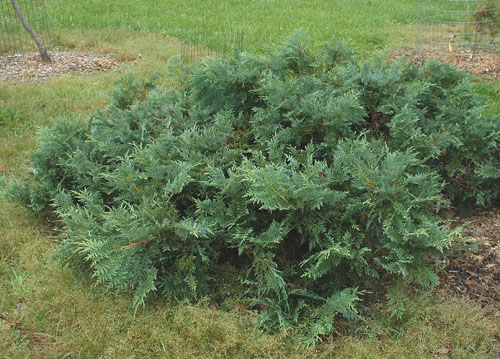
Thuja Korean, grade ‘Glauca Prostrata’
Choice of location
Thuja belongs to shade-tolerant plants, well perceives partial shading, but not full shade. In partial shade and in the sun it develops much better. Does not like winds and drafts. The ideal place for thuja suggests nutritious, but light soil; on dry or clay soils, the plants turn yellow and dry.

The ideal place determines the development of Tui
Landing
Landing is better in the spring, because during the summer the young plant will take root, gain strength for a successful wintering. Transplants can be planned for any period from spring to autumn. The size of the pit for planting is determined by the degree of development of the root system, as a rule, the pit reaches a diameter of at least one meter. For planting use drainage, for example, expanded clay, crushed stone. Above they place nutrient soil with fertilizers, in this case, fertilizing is not required for the first couple of years. Roots fall asleep with soil mixture consisting of ground soil, peat, sand.
The root collar is placed exactly on the ground level. If the depth is lower, the roots may rot, the trunk, if higher, the plant can dry out. The distance between seedlings depends on the variety - for compact varieties from 1 m, for tall ones - up to 5 m. When planning the hedges between plants, 1 m is left, regardless of the variety.
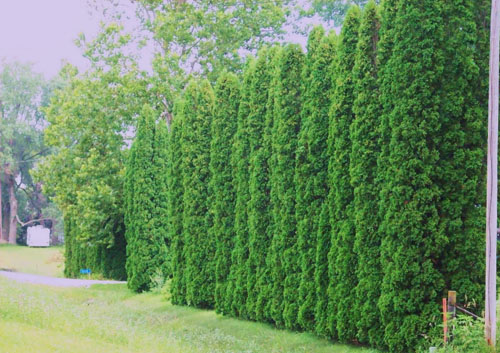
Tui hedge
Watering
Thuja is moisture-loving, responsive to regular watering, so you need constant monitoring of soil moisture. Growing and caring for thuja is recommended in places with a sufficient level of moisture. After planting, it is enough to water once in the amount of a 10-liter bucket for a week; in dry, hot weather, the frequency and rate of watering is doubled. Responds well to sprinkling procedure.
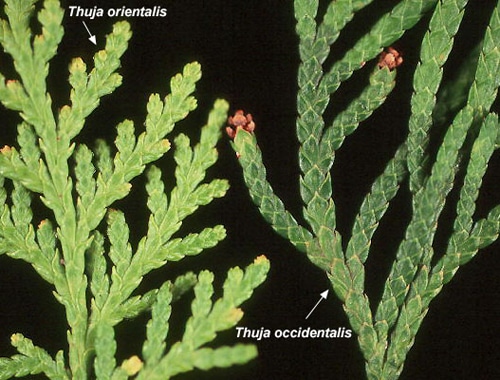
The difference between the leaves of thuja western and eastern
Feeding and mulching
Moderate feeding should begin in the spring, even in the presence of snow, using nitrogen fertilizers first. At the beginning of the summer, it is necessary to switch to potash preparations, on poor soils the use of phosphate fertilizers has a good effect. Fertilizers are better underdone than overdose. Overfed plants, especially young ones, can quickly grow, losing their original shape and species. Long-acting fertilizers are best applied in the spring, once.
Mulching is desirable. Peat is used, the chips are about 5 cm thick. Loosening is carried out at a layer thickness of no deeper than 10 cm to keep the surface root system intact.
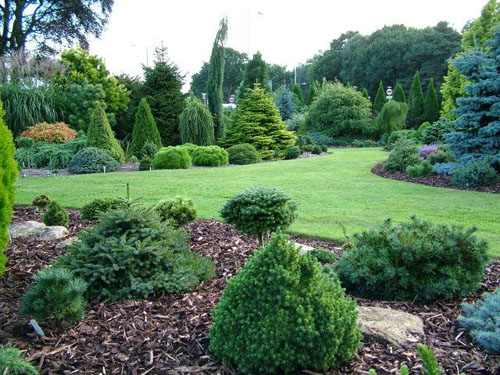
Mulching plantings
Forming and trimming
Every spring should remove dry, excess branches. Thuja loves haircuts, the more often she carries out the forming trim, the more dense and beautiful she gets. A moderate haircut should capture no more than a third of the length of the initial shoots.
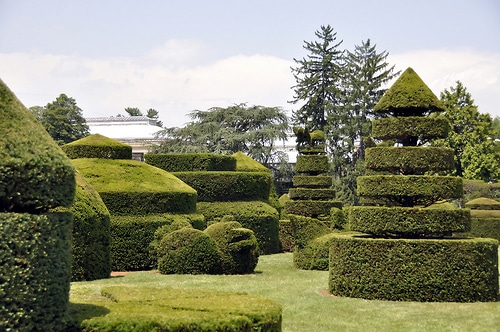
Topi haircut thuja
Wintering
In the first winter young saplings necessarily need warming. Preparations for the winter should begin in October-November, it will allow time to provide maximum protection. Even in the fall, each plant needs to be watered many times, the evergreen thuja also needs moisture in winter. As a heater, you can use straw, peat in the form of litter under the plant, it will serve as a kind of blanket for the root system. For young plants, spunbond or other covering material that transmits light is used on top, because photosynthesis in the leaves continues in winter. On sale there are special covers.
Adult plants do not require shelter, they need protection from wind and snow. Many thuya are badly preserved in conditions of heavy snow, especially wet, heavy. To preserve the integrity, decorativeness of the crown, multi-stemmed varieties of shrub thuja for the winter should be tied. For lush, multi-stemmed varieties, constant snow breaking is recommended, in order to avoid needling mold growth.

Shelter Tui for the winter
Breeding
Seeds
Cultivation of thuja from seeds is practiced when it is not necessary to fully preserve the decorative features of the future plant, since this type of reproduction does not imply the repetition of parental signs.
Thuja seeds ripen in the fall, this year is already suitable for sowing. They are dried indoors at low temperatures above zero, sieved, stored in a cool place until the snow falls. For winter, the seeds are collected in bags, laid on the ground, covered with a layer of snow up to 30 cm thick.
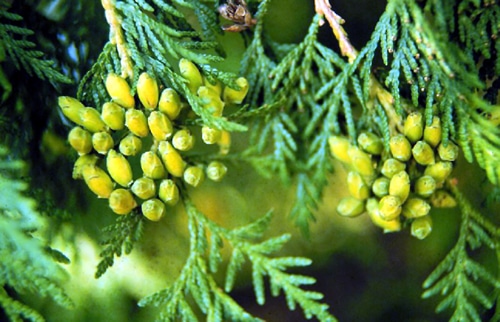
Thuja western cones
In the nursery, seeds are sown on ridges, leaving about 10 cm between rows. Saplings from seeds grow 5 years, but they are more adapted to local conditions. The best time for planting seeds is spring. Soils need to be nourished, the place is sunny, the depth of the bookmark is no more than 5 cm. The planting site is covered with a layer of pine sawdust from above, it helps to retain moisture and provides protection from direct rays of the sun, the young growth requires protection from the sun, otherwise shoots may die.
Shoots appear quickly, in the first year they reach 6-10 cm, each time they add 20 cm. Plants are quite tender, therefore weeding should be carried out carefully. The soil must be regularly loosened and moistened. In the third year, the young dive, on the fifth - in the spring they are transplanted to a place of constant growth.
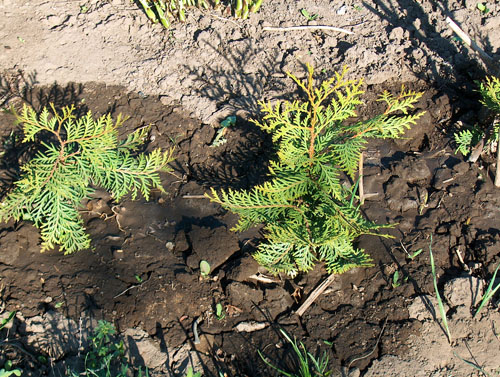
Thuja seed
Vegetative
For breeding varietal specimens using only vegetative propagation in the following ways:
- Scions;
- Horizontal layering;
- By division.
In practice, young plants are used for propagation of thuja cuttings, cuttings are taken from shoots aged 2-3 years. Annual shoots are cut with a heel - a small piece of wood. They must be semi-woody. Shoots selected from the top of the shrub inherit the parental traits much better. Before planting, the cuttings are treated with heteroauxin. For rooting is ideal for a mixture of equal quantities of peat, sod land. Planting depth up to 2.5 cm.
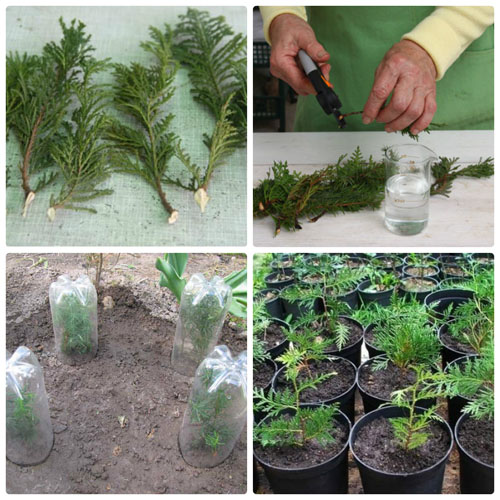
Tui cutting
Saplings are preferable to grow in greenhouses, where it is possible to provide protection from the sun, constant high humidity. In the open ground, modern sprinkling equipment is used to create artificial fog, or a combination of watering and shelter with a film, which in hot weather is recommended to be treated with lime.
Cuttings need hardening, which is to reduce watering and periodic ventilation. For the winter, they cover with sawdust, spruce pine branches, and protect them from above with a film in front of the frost. In the spring, warming is removed, the hotbed is carefully weeded.
For vegetative propagation by layering, the selected branch is lowered down, pinning it in the place of future rooting to the ground. Young seedlings respond positively to fertilizing with infusion of manure (concentration 1:20).
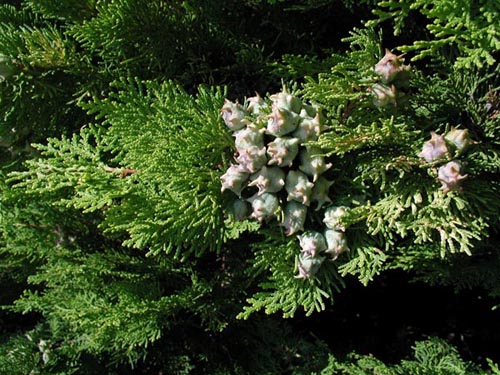
Eastern Thuja Cones
Diseases and pests
For the Thuy, they are threatened with false shields that are difficult to breed. Also dangerous is the massive spread of bolls. To protect the needles, branches apply spraying karbofos, Aktelik in early spring, summer and autumn.

Decorative planting thuja
Use in ornamental plantings
High resistance to polluted conditions of megacities makes it possible to use thuja in greening cities and even industrial facilities. In the decorative purposes used to create alleys, hedges, green walls dividing. Tui hedges are not only decorative, they perfectly disinfect the air and absorb noise.
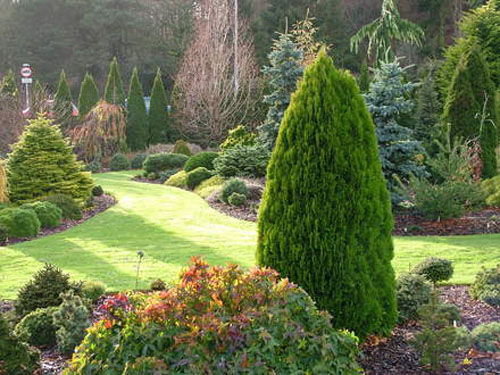
Tui compositions
All forms of thuya are very decorative:
- The typical form is ideal for creating group plantings, alleys;
- Dwarf forms are good for stony sites, they are often grouped to decorate rock gardens, rockeries;
- Weeping thuja looks spectacular alone on the lawn, near the water;
- Forms with multi-colored needles are used to create contrasting plant compositions.
The love of a haircut is widely used to create living architectural forms. Crowns of pyramidal and spiral shapes are popular, they are often cut in the form of columns, balls, fantasy figures. Tuyu is widely used for bonsai. Large plants are spectacular in single, group plantings.
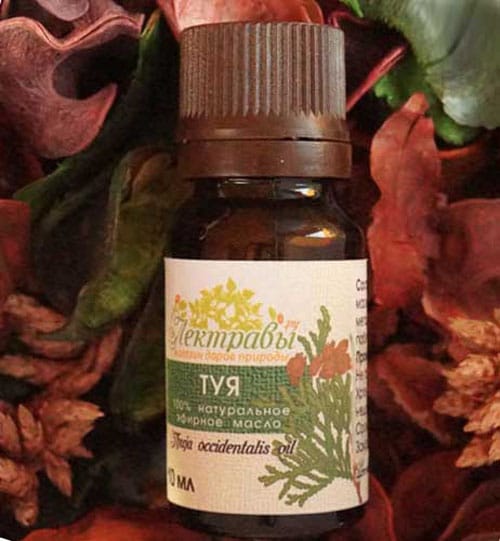
Thuja Essential Oil
Other uses
Wood and leaves of thuja contain essential oil with a pleasant smell, which is obtained from the distillation of leaves. It can be used in gardening as an insecticide.
In cosmetology for a long time, this oil is part of the components of nourishing, washing preparations for skin and hair care.
Thuja is popular in traditional medicine, in homeopathy. Aromatherapy with thuja oil, fragrant baths help to get rid of nervousness, restore vigor, lost strength, inhaling the smell raises the tone and ensures a good mood. The use of oil can improve digestion, eliminates inflammation in the kidneys, diseases of the respiratory system, skin. Its diuretic effect is known, as well as its ability to charge with optimism, vigor, cheerfulness.
